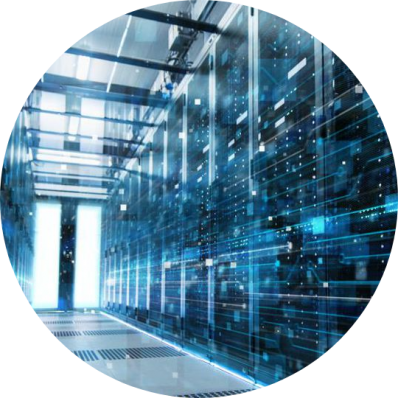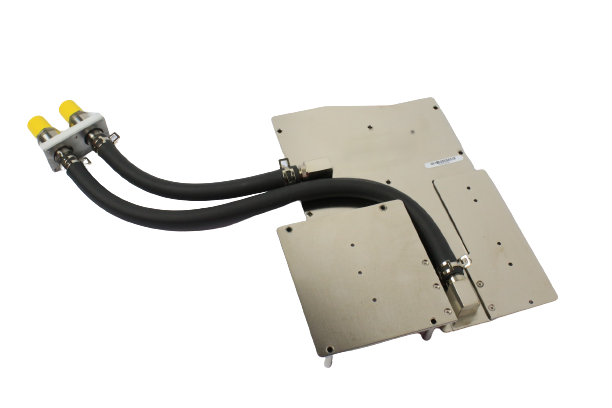Data Center Liquid Cooling
The rise of the data center has been fueled by the growth in cloud computing. Early data centers utilized the air cooling system of computer racks, but rapid scaling and the resulting high energy consumption costs quickly called for more efficient cooling solutions.
One way that data centers have kept up with the macro-scale impacts of rising power densities and waste heat production for high power computing is to employ liquid cooling.
A wide range of liquid cooling options allows data centers to employ thermal management designs that meet broad infrastructure needs with a greater return on their overall facility investment and more reliable overall compute performance.

Data Center Usage Trends
The following changes in High Performance Computing (HPC) systems and semiconductor chip designs have driven a shift to liquid cooling solutions:
Rack Density Increases
According to a 2019 survey, 45% of computing service providers plan for their computing racks to have average power densities greater than 10 kW per rack, a 22% increase from 2014. With current averages of 11-15 kW per rack, particularly demanding compute clients can require more than 30 kW per rack. As these power densities near the upper limit of cooling capacity for air-cooled systems, their diminishing ROI, in addition to the facility burden of large fans becomes a multi-faceted limitation for data center cooling systems.
High-Density Storage
High-density data storage systems also have heat generation concerns that prevent optimal date read/write speeds as newer designs condense more memory devices into smaller volumes.
AI Accelerators
Artificial Intelligence (AI) accelerators are increasingly used to meet consumer demands for Neural Network (NN) processing. These accelerators can present demanding thermal management needs due to the high-performance chips and compute power required.
Increasing Energy Costs
Data center operators consume significant amounts of energy — currently about 3% of the world’s electricity. As energy prices fluctuate with market uncertainty, reducing the energy required for an operation has a significant economic impact. Liquid cooling offers one of the most energy-efficient cooling methods available and data centers continue to investigate new methods to employ it.
Advantages of Liquid Cooling Data Center
Liquid cooling technologies provide several different benefits to data centers:
- Scalability: Because it allows for denser builds, liquid cooling makes it easier to scale operations and speeds the process to upgrade racks for emerging compute needs.
- Better use of storage space: Some liquid cooling solutions, including Mikros direct-to-chip designs, can work in very small volumes and are a great solution for Edge data centers, which typically need a very small footprint.
- System and Enery efficiency: The lower power required by Liquid cooling systems makes them more efficient, lowering your energy consumption and reducing cost and carbon footprint.
- AI capabilities: As AI compute becomes more integrated into cloud-based services, liquid cooling can help a data center accommodate the increased energy demands while maintaining essential chip temperatures.
- Increased reliability: A liquid cooling system can ensure more effective heat dissipation and temperature control, keeping components working in optimal environments with higher reliability.
Liquid Cooling Capabilities
The high heat transfer effectiveness and overall cost savings for liquid cooling technology are making it a new standard in rack cooling for data centers. As the field of liquid cooling continues to emerge, two popular approaches are gaining traction at scale, each with benefits and costs: immersion cooling and direct-to-chip cooling.
Immersion
In an immersion system, the rack hardware is submerged into a tank of non-conductive and nonflammable dielectric fluid. Heat is dissipated from the components into the fluid via convection as it flows through the rack. The components must be specifically suited to this environment and well-sealed in a leak-proof casing. Though heat transfer rates at the component boundary layer are not as good as direct-to-chip cooling, the large volume of fluid in the immersion tank serves as an additional heat sink with thermal capacitance, helping to spread heat throughout the fluid. The resulting heated fluid then flows through a heat exchanger to move the thermal power out of the facility and return the liquid coolant to a sufficiently low inlet temperature.
Rack-based computing systems must be specifically designed for liquid immersion cooling, and it requires significant facility investment to incorporate as a fully thermal management ecosystem at scale.
Direct-to-Chip Cooling
This form of liquid cooling utilizes a targeted heat transfer mechanism, often called a “cold plate” or “heat sink,” mounted directly onto high power rack components to distribute coolant to areas of high thermal power emission. This more traditional method of cooling can be incorporated and upgraded more easily as computing needs and components rapidly evolve. Within cold plate technology, heat transfer performance can differ dramatically, depending on the internal design for coolant flow, and performance changes are more easily quantifiable. Direct-to-chip cooling requires much less capital expense and is suitable for a wide range of applications.
Mikros Technologies designs microchannel cold plates for the “direct-to-chip” class of liquid cooling solutions. Microchannels offer the highest heat transfer performance for localized liquid cooling solutions, as the core thermal resistance of a cold plate (the additional temperature increase per Watt applied) is directly proportional to the coolant flow channel diameter. For direct-to-chip solutions, Mikros has industry leading low thermal resistance, making the cooling system much more efficient and saving energy costs for data centers that utilize us.

Mikros Technologies for Data Center Cooling Solutions
At Mikros Technologies, we specialize in extreme direct-to-chip liquid cooling and can provide custom data center liquid cooling solutions specific to your system’s thermal management demands. We offer some of the highest cooling capacities in small, versatile packages and can be incorporated into current rack cooling structures. Our high-performance microchannel cold plates can help data centers provide their clients with the highest performing compute services while growing in agility and cost-effectiveness. To learn more about how a system from Mikros Technologies can improve your data center’s cooling efficiency, reach out to us today or give us a call at 603-690-2020.